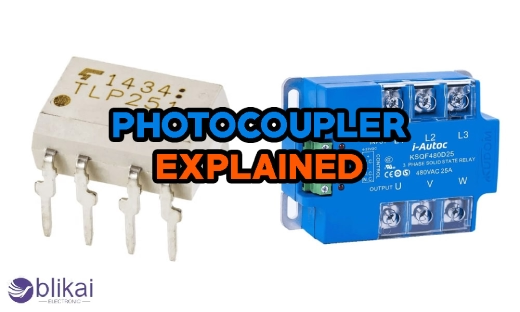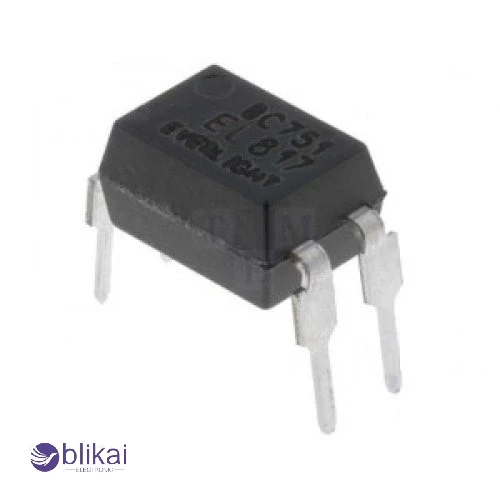Photocoupler: Definition, Applications and Working Principle
Photocouplers. There's a good chance you've seen one, but didn't give it much thought. The device is small, but it has a big job to do. In essence, it protects circuits by transmitting signals through light. Just light, no electricity. You don't have to worry about sensitive parts of your electronics being damaged by high-voltage systems. Think about it: you're building a circuit, and you don't want it to fry if a surge occurs suddenly. Photocouplers play a crucial role here. Circuit isolation is achieved by it. Communication without contact. There are also lots of them around. Their quiet, efficient operation ranges from power supplies to microcontrollers. Among the unsung heroes of the electronics industry.

What is Photocoupler?
Despite its size, photocouplers are powerful devices. Despite its name, it allows signals to be transferred between circuits without a direct electrical connection. It uses light instead. A LED is attached to one side and emits light when electric current passes through it. This light is captured by a phototransistor or photodiode, which converts it into an electrical signal. The message is carried between two parts without ever coming into contact.
Why is this important? There can be fragility in circuits. They can be fried in an instant by high-voltage signals. Photocouplers play an important role in separating high-voltage and low-voltage parts of your system. It acts as a protective shield, preventing damage to electronic components caused by dangerous surges. In the background, you'll find microcontrollers and power supplies doing their jobs quietly.
Working Principle
Here are the steps involved in using a photocoupler. The first thing you need to do is create two circuits. There is a high voltage one and a low voltage one. Magic happens when they don't touch-that's where it happens. A photocoupler consists of an LED and a phototransistor, which is a photosensitive element. Light is produced when an electrical signal is applied to the LED. Isn't that simple? I have a problem, however: the LED is not connected to the other side.
In most cases, LED light travels through a few layers of air or plastic before reaching its destination. Isolation is what makes the system work. The only thing that can cross is light, not electricity. The phototransistor, on the other hand, is awaiting. A light signal will be captured and converted back into an electrical signal by it. A phototransistor's conductivity changes depending on the intensity of the light. It is also the output signal that changes depending on how bright or dark the light is. In other words, it's the same signal as the original, except that it's on the other side, and the circuits are safe.
As a result of this process, signals pass between circuits without ever coming into contact. There are three things you love about it: it's clean, it's safe, and it's fast. There are no spikes of high voltage. Maintaining isolation between systems while still communicating is the key.

Applications
Power Supplies
Power supplies are filled with photocouplers. When high-voltage and low-voltage circuits are working together in switching power supplies, they are essential. Circuits with high voltage can easily fry ones with low voltage. Photocouplers step in to solve this problem. In this way, the low-voltage control portion is isolated from the high-voltage switching portion, ensuring safety. The power supply can also be adjusted correctly without risking damage thanks to feedback loops. There is no risk of sudden surges causing anything to break, so everything runs smoothly and safely.
Microcontroller Interfacing
Working with microcontrollers often involves sensitive components. It's easy to control low-voltage devices with microcontrollers, but what about high-voltage devices? Photocouplers do that kind of work. Microcontrollers send signals to photocouplers, which transmit those signals to high-voltage systems. No electrical connection. It's just light. Microcontrollers with this protection are safe from high-voltage damage, allowing them to control big devices such as motors and relays.
Signal Isolation
Have you ever experienced a circuit being interfered with by noise or voltage spikes? Industry and data communication settings often experience this issue. Photocouplers can help prevent noise transfer between circuits due to isolation of signal paths; electrical noise must remain out of the path when sending data between high-voltage industrial systems and low-voltage controllers for clean transmission of information - using photocouplers allows data transmission without obstruction from external interference while still passing cleanly and clearly between two systems; all bad stuff gets blocked off while quality data passes through unimpeded.
Relays and Switching
Electrical relays switch electric loads in automation and control systems, but they can be tricky when voltages are high and low. The photocoupler plays a crucial role here. Unlike relays, they do not require physical contact. LEDs in photocouplers are triggered by a low-voltage input signal. On the high voltage side, the electrical signal is converted to a light signal and activated by a relay. The connection is indirect. It's just light. Low-voltage signals are used to control large loads while keeping things safe.
Data Communication Systems
Signals need to be transferred fast, cleanly, in high-speed data transmission. Signals are ensured to get through without interference with photocouplers. By maintaining isolation, they are able to transmit data without being affected by spikes or noise. Photocouplers play a crucial role in systems with multiple components, such as communication boards, to maintain data integrity. Essentially, they prevent high-voltage disruptions while maintaining data integrity.
Audio Systems
Electrical noise can severely impair audio system sound quality. To address this problem, photocouplers provide isolation between various audio components; audio signals may pick up unwanted noise as it travels throughout your system; each part of a photocoupler acts independently from one another to reduce interference between signals preventing interference between signals preventing unwanted sounds from permeating through and disturbing sound quality. Although you might not notice its benefits immediately, photocouplers play an essential role in keeping sound smooth and uninterrupted.
Switching Circuits in Automotive Systems
Several components of automotive systems must operate at different voltage levels due to their complexity. Isolation is crucial whether you're controlling lights, sensors, or your vehicle's infotainment system. The photocoupler shines here. Circuits like microcontrollers are isolated from high-voltage power circuits in the vehicle by these devices. The main control unit of the car receives data from a sensor. Microcontrollers could be destroyed by voltage spikes without isolation. With a photocoupler, the signal passes safely, preventing costly repairs and smooth operation of your car's electronics.
Isolating AC Mains Signals
Photocouplers are used in household appliances as well as industrial machines designed to handle AC mains signals safely, such as air conditioners or motors. Directly connecting low-voltage control systems to AC mains circuits poses a great danger; photocouplers connect this side of the system to its counterpart from above so signals can pass while dangerous currents are blocked; thus protecting low-voltage electronics while keeping them functioning effectively, whether for controlling air conditioners or motors.
Pulse Width Modulation (PWM) Circuits
Hundreds of electronic devices use PWM circuits, including motors and LED dimmers. However, to work effectively, these circuits require clean, precise signals. The photocoupler provides distortion-free transmission of PWM signals in these systems. Input and output sides are isolated, so noise is prevented from affecting the accuracy of the signal. The signal stays sharp, so you can control a motor's speed or adjust a light's brightness without interruption. What is the result? No hiccups, smooth, efficient operation.
Telecommunication Systems
A telecommunication system involves long-distance signals that can be severely hampered by noise or interference. Using photocouplers, telecommunication equipment isolates different stages, preventing noise or voltage spikes from corrupting data signals. In routers, modems, and communication relays, photocouplers protect the signal integrity as well as sensitive equipment. It ensures clear and uninterrupted phone calls and internet connections, serving as an unsung hero.
Faqs
Question : What is the Function of a Photocoupler?
Answer: Opto-isolators (also referred to as optocouplers, photocouplers or optical isolators) utilize light waves in order to transfer signals between isolated circuits while protecting signal receiving systems against voltage spikes.
Final Verdict
Despite their small size, photocouplers are essential. Communication between circuits is made safe without any contact between them. Are there spikes of high voltage? It's no problem. Parts that are sensitive remain protected. Microcontrollers and power supplies both use them. Signals are transferred by light, which keeps things safe. It is they who ensure that your electronic systems run smoothly, without any hiccups. Using a photocoupler ensures safety and reliability. Tech today isn't just about parts, they're about essential components.
Exploring Electronic Components: Innovations and Applications
Exploring Electronic Components(Guide)
What is an Electronic Speed Controller and How Does it Work?
What is an Electronic Fuse? All You Need to Know
Carbon Film vs Metal Film Resistor
Run Capacitor vs Start Capacitor
What is an Air Core Inductor? [Everything Explained]
NPN VS PNP BJT Transistor: Common Knowledge
Temperature Coefficient of Resistance
ESP32 vs ESP8266: Which One Should You Choose?










